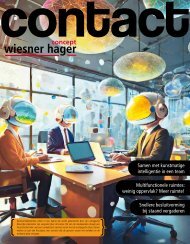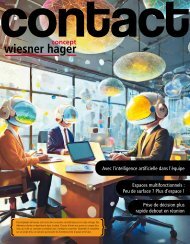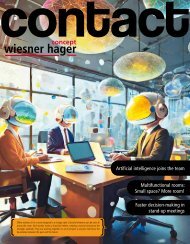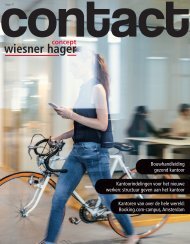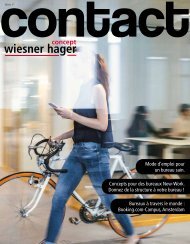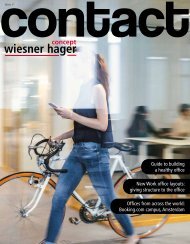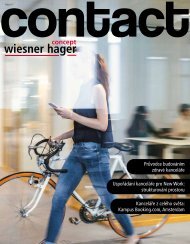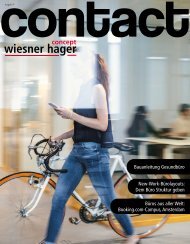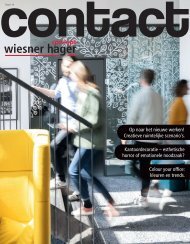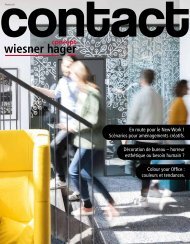contact_magazine_#36_EN
The way from the traditional office to the New Work office has turned out to be the hottest challenge of today. Traditional mindsets regarding organisation and leadership are a thing of the past. Joining forces with the architect Martin Thörnblom, an expert for innovative office concepts, we’ve booked a discovery trip to New Work and composed the title story based on the valuable experiences made on the journey.
The way from the traditional office to the New Work office has turned out to be the hottest challenge of today. Traditional mindsets regarding organisation and leadership are a thing of the past. Joining forces with the architect Martin Thörnblom, an expert for innovative office concepts, we’ve booked a discovery trip to New Work and composed the title story based on the valuable experiences made on the journey.
- No tags were found...
You also want an ePaper? Increase the reach of your titles
YUMPU automatically turns print PDFs into web optimized ePapers that Google loves.
Office Concepts<br />
Basic typology of office work.<br />
Within these four basic types of office work, various spatial ideas can be realised that are adapted to different requirements.<br />
The following six examples can serve as inspiration for modern worlds of work:<br />
Library<br />
No, this isn’t (only) about books! Although<br />
most firms in the digital age no<br />
longer need the traditional function<br />
of the library, we still love the vintage<br />
charm of libraries. They offer an ideal<br />
place of retreat – off the beaten track<br />
of the dynamic, occasionally hectic<br />
environment of the office. The creative<br />
options offer wide-ranging scope:<br />
cosy wing chairs are equally part of<br />
the scene as modern cafeteria furniture.<br />
And of course, the characteristic<br />
library shelves are indispensable.<br />
Coworking<br />
Landscape<br />
Even more than concentrated work,<br />
coworking zones are vital in that<br />
people from different offices and<br />
departments interact and sound out<br />
areas of <strong>contact</strong> for cooperation. As<br />
regards interior design, coworking<br />
spaces offer much scope for freedom:<br />
industrial style, living-room, lounge<br />
or open space, biophilic environment<br />
or urban marketplace.<br />
Open Units<br />
Open units are integrative components<br />
of an open space concept but<br />
structured into smaller spatial units<br />
and – depending on purpose – more<br />
or less visually and acoustically<br />
screened off. The unit idea, as we<br />
know it from organisation theory, is<br />
also implemented in spatial terms.<br />
The main purpose of these organisational<br />
units is to support collaboration.<br />
In creative and innovative<br />
processes the units support openness<br />
of thinking on one hand, and on<br />
the other offer the required privacy<br />
to facilitate concentrated team and<br />
project work.<br />
Scrum & Design<br />
Thinking<br />
In scrum project management and<br />
design thinking used as a problemsolving<br />
strategy, the environment<br />
takes shape as sort of an agile project<br />
office. This concept demands a very<br />
flexible and mobile spatial structure,<br />
because in every sprint and project<br />
phase different team members work<br />
together more closely than others.<br />
Not only open room structures but<br />
also expansive visualisation tools<br />
like flat screens and whiteboards are<br />
typical of scrum spaces.<br />
Lean Coffee<br />
Openly discussing important topics<br />
in a relaxed café atmosphere – this<br />
puts in a nutshell the basic principle<br />
of Lean Coffee, a very special format<br />
for meetings. The optimal spatial<br />
option therefore avails of flexible furnishings,<br />
particularly for discussions<br />
while standing. Obviously, another<br />
important aspect is communication<br />
and presentation equipment such as<br />
whiteboards (increasingly digital) and<br />
flip charts. And, of course, a coffee<br />
machine.<br />
Marketplace/<br />
Community Space<br />
A quick coffee with workmates, an<br />
informal talk or a relaxed meeting –<br />
the marketplace is the central meeting<br />
point in the office. Characteristic<br />
features of this area are the various<br />
levels of the furniture: high table, bar<br />
sections, also a comfortable lounge<br />
area – the range of furnishings is<br />
unlimited. This is where you take a<br />
break, meet people and chat, but also<br />
work – thus creating a public zone of<br />
informal character.<br />
8 <strong>contact</strong><br />
<strong>contact</strong> 9




